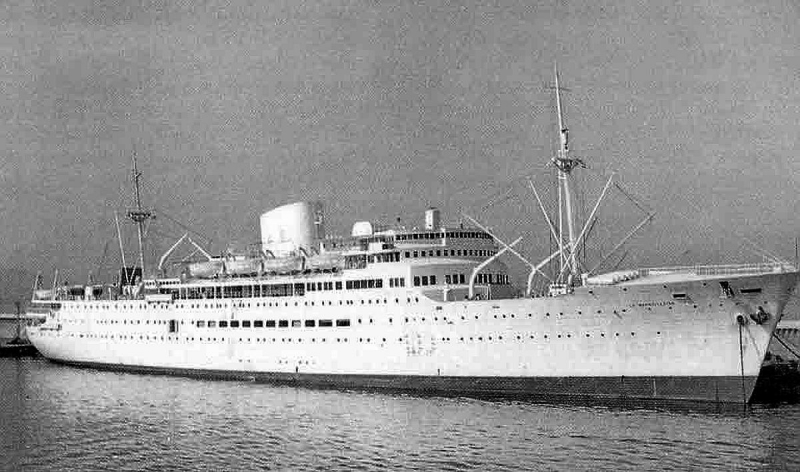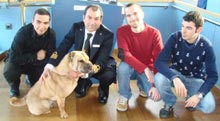| Precedente Successiva |
 |
| La Marselleise |
| Ex Names: Marechal Petain, La Marselleise, Arosa Sky, Bianca C Length: 593 feet. Breadth: 75.50 feet Gross Weight: 17,321 tons; 18,427 tons as Bianca C Engines: 3 x 8,330 bhp @ 131rpm or 10,330 bhp @ 141rpm Screws: 3 Maximum speed: 22 knots Passengers: 344 1st, 74 2nd, 318 3rd as La Marseillaise; 202 1st & 1,030 tourist as Arosa Sky At the outbreak of World War Two the Constructions Navales shipyard at La Coitat was in the process of laying down the keel for a new vessel. The war slowed down the building of this vessel, it was not until 1944 that it was launched, named Marechal Petain. The unfinished hull was towed to Port Bouc to await the end of the war. However in August 1944 the retreating Germans sank the ship in shallow waters. The ship's owners raised the vessel during 1946 and moved it to Toulon, despite its sinking the damage sustained was minimal. The ship returned to its original builders for repair and fitting out, by 1949 it was ready to be placed into service. Its name had been changed, the former name was now associated with the collaborationist and very unpopular Vichy regime of the Nazi occupation, the more patriotic La Marseillaise was chosen. Passenger accommodation and facilities ranged from A Deck to F Deck and included: A Deck: The kitchen servicing the First Class Dining Room. A portion of the Dining Room ceiling was cut away into B Deck. B Deck: First Class Cabins Nos 147 - 165 odd numbers (port side) First Class Cabins Nos 144 - 180 even numbers (starboard side) Tourist Class Cabins Nos 167 - 185 odd numbers (port side) Tourist Class Cabins Nos 182 - 208 even numbers (starboard side) All cabins had washbasins, but baths, showers and toilets were located in the center of the deck. C Deck: First Class Cabins Nos 101 - 145 odd numbers (port side) First Class Cabins Nos 102 - 142 even numbers (starboard side) All cabins on this deck contained either a shower and/or a bathtub, not all contained a toilet, rooms containing six toilets and several bathtubs were located in the center of the deck. This deck contained two deluxe suites, the Provence (port side) & the Cote d'Azur (starboard side) C Deck also contained the Barber Shop & Beauty Parlor, the Surgeon and the Pursers. D Deck: First Class Cabins Nos 1 - 99 odd numbers (port side) First Class cabins Nos 2 - 100 even numbers (starboard side) D Deck was the only deck with symmetrical passenger accommodation for the port & starboard sides. Most cabins had a shower, some were equipped with a toilet. Other toilets and bathtubs were located at either end of the deck or in small rooms alongside the passageways providing access to the cabins. This deck contained the Children's playroom, the First Class Swimming Pool - a cut out in E & F Decks provided natural light for the pool. E Deck: There were no passenger cabins on this deck, but it featured the First Class Verandah Cafe (overlooking the bow), First Class Smoking Room, First Class Drawing Room, the Writing Room, the Bridge Room and towards the stern the Tourist Class Bar & Smokeroom. F Deck: Whilst the F Deck carried many of the ship's offices, the passenger Gymnasium was located at the rear of the deck. Two classes of passengers only are to be carried, in contra distinction to some French ships, which sometimes carry five classes and sub-classes. There will be only 374 passengers in first and tourist, but there are interchangeable cabins, so that first class and tourist may be increased or decreased as desired. Some 260 emigrants and deck passengers can also be carried. The ship had been fitted out for working the route to the French colonies in South East Asia, in this case Saigon, making her maiden voyage on August 19th 1949. Ports of call included Port Said, Djibouti, Colombo, Singapore, Saigon, Hong Kong & Manila. The ship remained on this run until early in 1954. The sun had set on the French colonies in the Far East, the need for ships like La Marseillaise had greatly diminished. The ship was reallocated to Mediterranean duties, but proved unsuitable for this, her French registry also provoked resentment due to French military action in Algeria. The ship was commandeered by the French government in the Algerian crisis and later in 1956 for the Suez crisis, when it made two sailings as a hospital ship, in addition to being a troop carrier. When the ship was returned to Messageries Maritime in February 1957 it was obvious that it no longer had a future under its existing role. As a result the ship was almost immediately sold to the Panama based Arosa Line and renamed Arosa Sky, see view below. Her passenger accomodation was reconfiguered to cater for the predominantly tourist class passengers that the ship was aiming to cater to. The first voyage under the new owners was on May 10th 1957 from Bremerhaven to New York. Within a year the Arosa Line was facing bankruptcy, the ship being sold on to the Costa Lines After a refit the ship entered service during 1959, now named the Bianca C, see view below, working the Naples - Genoa - La Guaira (Venezuela) circuit. The ship's last voyage commenced on October 12th 1961, on the regular route from Naples to La Guaira. Ten days into the trip whilst anchored in the harbour at St George, Grenada an explosion in one of the engine's air manifolds ruptured a nearby fuel tank. This explosion started a fire which could not be contained and spread throughout the ship. The quiet Sunday morning was soon disturbed by the Bianca C's whistles sounding the emergency alarm. The town's residents responded magnificently, literally using whatever was afloat in the harbour to assist the evacuation of the ship's passengers and crew. Such were their efforts that of the 673 people on the ship only three died in the tragedy, one crewman was killed in the initial explosion, two other crew died later of their injuries. The fire burned out of control for several days - the crew were never able to use the onboard firefighting equipment and the port of St George had nothing suitable for such a large fire. A nearby naval vessel, the British frigate HMS Londonderry out of Puerto Rico was summonsed to provide assistance, the port authorities were concerned the ship might sink and block the harbour channel, however the captain would not allow the Bianca C to be moved until properly inspected. The decision was made to tow the ship from the harbour and beach her in nearby shallow water. The tow was only partially successful, the ship was able to clear the harbour, but controlling the ship in open water with a jammed rudder was too much for the small frigate. The tow line eventually parted, the ship started to take on water and sank on an even keel in waters 150 feet deep about one mile from Port Saline. The Bianca C came to rest upright on a sandy part of the ocean floor. The stern separated from the rest of the ship coming to rest on its starboard side. Because of the proximity of the wreck to St George it became a major attraction for divers. The wreck has been looted of its more valuable scrap metals, brass etc, and most notably its bronze propellors. The damage caused by the fire and its four decades on the ocean floor have considerably weakened the structure to the extent that it is now starting to collapse in on itself. |
| Username | |
| Armatore | |
| Ship manager | |
| Numero IMO | |
| Classificazione | |
| Cantiere e anno di costruzione | |
| Data | |
| Luogo | |
| Aggiunta il | 02/02/2019 |
| Dimensioni | 1200 x 708 |
| visite | 1135 |
















